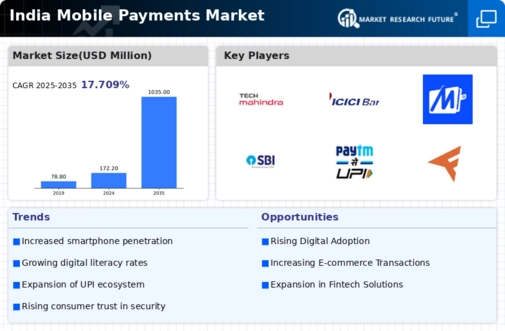E-commerce Expansion
The rapid expansion of the e-commerce sector in India is a crucial driver for the mobile payments market. With online retail sales projected to reach $200 billion by 2026, the demand for efficient payment solutions is escalating. Consumers increasingly prefer mobile payments for their convenience and speed, particularly in the context of online shopping. This trend is further supported by the proliferation of mobile applications that facilitate seamless transactions. As e-commerce continues to grow, the mobile payments market is expected to benefit significantly, as more consumers opt for digital payment methods to complete their purchases.
Increased Consumer Awareness
Consumer awareness regarding the benefits of mobile payments is on the rise in India, contributing positively to the mobile payments market. Educational campaigns and marketing efforts by financial institutions and payment service providers have played a pivotal role in informing consumers about the advantages of using mobile payment solutions. As of 2025, surveys indicate that approximately 70% of consumers are aware of mobile payment options, leading to increased adoption. This heightened awareness not only encourages usage but also fosters trust in digital transactions, which is essential for the sustained growth of the mobile payments market.
Rising Smartphone Penetration
The mobile payments market in India is experiencing significant growth due to the increasing penetration of smartphones. As of 2025, smartphone users in India are projected to reach approximately 1 billion, which represents a significant portion of the population. This widespread adoption facilitates access to mobile payment applications, enabling users to conduct transactions seamlessly. The convenience offered by smartphones, combined with the availability of affordable data plans, encourages consumers to engage in digital transactions. Consequently, this trend is likely to drive the growth of the mobile payments market, as more individuals embrace technology for everyday financial activities.
Emergence of Fintech Innovations
The mobile payments market in India is experiencing a wave of fintech innovations that are reshaping the landscape of digital transactions. Startups and established companies are introducing advanced payment solutions, such as peer-to-peer lending and blockchain-based transactions. These innovations enhance the user experience by providing faster, more secure, and cost-effective payment options. As of 2025, the fintech sector is expected to attract substantial investments, further driving the growth of the mobile payments market. The integration of cutting-edge technology not only meets consumer demands but also positions India as a leader in the mobile payments ecosystem.
Government Initiatives and Support
The Indian government has been actively promoting digital payments through various initiatives aimed at enhancing financial inclusion. Programs such as Digital India and the introduction of the Unified Payments Interface (UPI) have significantly contributed to the mobile payments market. As of 2025, UPI transactions have surged, with over 45 billion transactions recorded in the previous year alone. These initiatives not only provide a robust infrastructure for mobile payments but also instill consumer confidence in digital transactions. The government's commitment to fostering a cashless economy is likely to further propel the mobile payments market in India.

















Leave a Comment